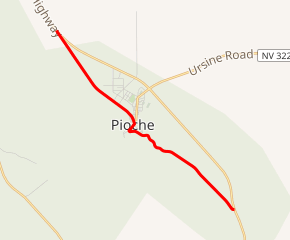Nevada State Route 321
State Route 321 (SR 321) is a state highway in Lincoln County, Nevada, serving the town of Pioche.
| ||||
|---|---|---|---|---|
| Pioche Road | ||||

SR 321 highlighted in red | ||||
| Route information | ||||
| Maintained by NDOT | ||||
| Length | 5.113 mi[1] (8.229 km) | |||
| Existed | 1976–present | |||
| Major junctions | ||||
| South end | ||||
| North end | ||||
| Highway system | ||||
| ||||
Route description
View from the south end of SR 321 looking northbound
This loop route connects to U.S. Route 93 (US 93) on both sides via the town of Pioche. Another nearby loop route of US 93, State Route 320, bypasses Pioche altogether and instead serves the Caselton Mine. Within Pioche, State Route 321 serves as the terminus for State Route 322.
Major intersections
The entire route is in Lincoln County.
| Location | mi | km | Destinations | Notes | |
|---|---|---|---|---|---|
| | |||||
| Pioche | |||||
| | |||||
| 1.000 mi = 1.609 km; 1.000 km = 0.621 mi | |||||
gollark: It... er... cactus?
gollark: It's a regular cactus, with some electrodes in it.
gollark: My latest one, the electronic cactus.
gollark: ... probably not.
gollark: Say, two USB-C ports and maybe a USB-A one.
See also
| Wikimedia Commons has media related to Nevada State Route 321. |


References
- Nevada Department of Transportation (January 2017). "State Maintained Highways of Nevada: Descriptions and Maps". Retrieved 2017-04-14.
This article is issued from Wikipedia. The text is licensed under Creative Commons - Attribution - Sharealike. Additional terms may apply for the media files.
